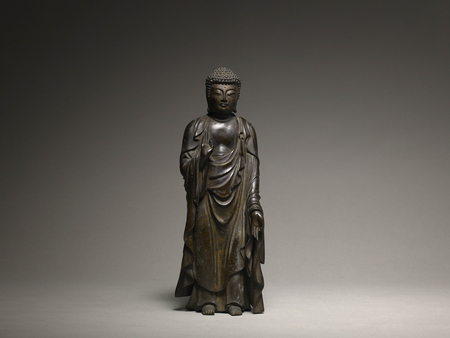Product Description
7712 A gilt lacquer bronze figure of a standing Amida Nyorai (Amitābha)
The right arm raised and the left arm extended with the forefinger and thumb of each hand forming a circle, representing the raigōin mudra, welcoming the believer into Amida’s Great Western Paradise. The forehead is decorated with a byakugō (white spiralling hair) the robe is delicately cast with flowing details.
Japan 14th century Kamakura period, dated 1318
Dimensions: H. 30cm x W. 9cm x D. 7.5cm (12” x 3 ¾” x 3”)
Inscribed:
Odanna Seimei juni-dai-matsu [Major patron (of the temple), the 12th generation of (Abe no) Seimei]
Yo Oinosuke Abe Masayuki [Abe Masayuki (in the ministerial position of) Oinosuke*]
Bunpo ni-nen Tsuchinoe-uma hachi-gappi keihaku [humbly (recorded in) August 1318]
* Oinosuke:
Oi is the abbreviation of Oiryo, one of the ministries of the Imperial Household at the time. It was in charge of arranging banquets and offerings at both Buddhist and Shinto religious ceremonies held at the Imperial Court as well as the management of lands owned by the Imperial Family. Suke of Oinosuke was the second top position, i.e. the deputy minister of this ministry.
According to the inscription, this figure was commissioned by the major patron Abe (no) Masayuki in August 1318. Abe (no) Masayuki was the 12th generation of Abe no Seimei and in the ministerial position of Oinosuke.
Increased activity of the Jōdō sect from the early Kamakura period ignited great interest in the worship of Amida, resulting in a strong demand for devotional images. Bronze sculptures such as this are thought to take their inspiration from a triad group of Amida and two attendant bodhisattvas enshrined at Zenkōji Temple, Nagano Prefecture. This model group was purportedly brought from the Korean kingdom of Kudara when Buddhism was introduced into Japan in the 6th century.
Belief in Amida as Lord of the Western Paradise rose in popularity during the late 10thcentury. Based primarily on the concept of salvation through faith, it was not only a religion which appealed to a broad range of people, but also a direct assertion of piety against the dogmatic and esoteric ritual of the more traditional Tendai and Shingon sects. In Amida’s Western Paradise the faithful are reborn, to progress through various stages of increasing awareness until finally achieving complete enlightenment.
For comparable bronze figures from Kamakura period, see:
Nara National Museum, Bronze Sculpture of the Heian & Kamakura Periods (Special Exhibition), (Kyoto, 1976), p. 23, no. 47 (Yakushi Nyorai, Ryūsenji temple, Akita), no. 48 (Yakushi Nyorai, dated 1248, Ryūzen, Obama-city, Fukui), p. 32, no. 74 (Amida Nyorai, dated 1314, Kinonesawa, Chiba), p. 34, no. 81 (Yakushi Nyorai), p. 41, no. 98 (Zenkōji-style Amida, dated 1254, Tokyo National Museum), p. 42, no. 101 (Zenkōji-style Amida, Fudōin temple, Wakayama)
Victor Harris and Ken Matsushima, Kamakura: The Renaissance of Japanese Sculpture 1185-1333, (British Museum, London, 1991), pp. 124/125, no.38 (Amida Nyorai, dated 1300, Seikōji temple, Chiba).
For a similar example in wood, see:
Asia Society ed., Kamakura, Realism and Spirituality in the Sculpture of Japan, (New Heaven and London, 2016), p.110-111, no. 29 (Shaka Nyorai, c. 1300, Museum Rietberg Zurich, RJP20).










